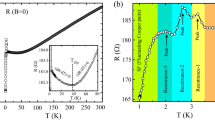Abstract
Granular aluminum films prepared by evaporation in the presence of oxygen show two different behaviors when the oxygen content is increased. First, the average grain size (as measured by the dark-field electron microscopy technique) is reduced and the critical temperature is increased. This increase is neither due to a variation of the lattice parameter which, following our measurements, stays constant and equal to the value of pure Al, nor to a purely electronic effect linked to the small grain size, because in this first regime the grains are essentially in good electrical contact. In a second stage, the average grain size changes little but the mean free path becomes much smaller than the grain size, indicating a build up of insulating barriers between the grains. The critical temperature decreases and the transition becomes broader as the normal-state resistivity increases. We attribute this behavior to the appearance of large critical fluctuations, due to the fact that the decoupled grains tend to have a zero dimensionality.
Similar content being viewed by others
References
W. Buckel and R. Hilsch,Z. Physik 138, 109 (1954).
See, for instance, B. Abeles, R. W. Cohen, and G. W. Cullen,Phys. Rev. Letters 17, 632 (1966).
R. H. Parmenter,Phys. Rev. 166, 392 (1968).
A. Paskin, N. R. L. report 6986, 14 (1969).
V. L. Ginzburg,Contemporary Phys. 9, 355 (1968).
J. J. Hauser,Phys. Rev. B3, 1611 (1971).
B. Abeles and J. J. Hanak,Phys. Letters 34A, 165 (1971).
K. Meyerhoff,Z. Naturf. 12a, 23 (1957);Acta Cryst. 12, 330 (1959).
B. W. Delf,Brit. J. Appl. Phys. 14, 345 (1963).
V. Novotny, P. P. M. Meincke, and J. H. P. Watson,Phys. Rev. Letters 28, 901 (1972).
V. V. Schmidt,Proc. of L.T. 10,2B, 205 (1966).
K. Maki, J. P. Hurault, and M. T. Beal Monod,Phys. Rev. B3, 762 (1971).
G. Deutscher,Phys. Letters 35A, 28 (1971).
L. Gunther, G. Deutscher, and Y. Imry, submitted toPhys. Letters.
P. G. de Gennes,Tokyo Lectures in Theoretical Physics, R. Kubo, ed. (Benjamin, New York, 1966), Vol. I, p. 117.
B. D. Josephson, inSuperconductivity, R. D. Parks, ed. (Marcel Dekker, New York, 1969), p. 423.
V. L. Ginzburg,Fiz. Tverd. Tela 2, 2031 (1960) [English transl.,Soviet Phys.—Solid State 2, 1824 (1960)].
Author information
Authors and Affiliations
Additional information
On leave from Université de Paris-Sud, 91-Orsay, France.
On leave from University of Cincinnati, Cincinnati, Ohio.
On leave from Universidad de Chile, Santiago, Chile.
Rights and permissions
About this article
Cite this article
Deutscher, G., Fenichel, H., Gershenson, M. et al. Transition to zero dimensionality in granular aluminum superconducting films. J Low Temp Phys 10, 231–243 (1973). https://doi.org/10.1007/BF00655256
Received:
Issue Date:
DOI: https://doi.org/10.1007/BF00655256




